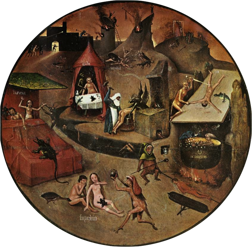The Deadly Sins
Seven Tangos for Piano Trio (2006-2008)
Duration: 38 minutes
I. Tango Hybris (pride)
II. Tango Acedia (sloth)
III. Tango Invidia (envy)
IV. Tango Avaritia (greed)
V. Tango Luxuria (lust)
VI. Tango Gula (gluttony)
VII. Tango Ira (wrath)
Performed by Trio Nova:
Terés Löf, piano, Klara Hellgren, violin, and Kati Raitinen, cello.
Live recording of the world premiere in Allhelgonakyrkan, Stockholm, on 21st February, 2009.
Score
Published by Gehrmans.
Commentary
The concept of deadly sin has its roots in a passage in the Old Testament, and was designated dogma by the medieval Christian Church under Pope Gregory I. The Church discriminates between venial, or lesser, sins, which may be forgiven, and so-called deadly sins, each and every one of which is fully sufficient to condemn the soul to perpetual suffering in Hell.
The tango, on the other hand, arose as musical entertainment in the brothels of Buenos Aires. It was a form of dance where buyers and sellers of sexual services were able to get acquainted. During the 20th century, the tango underwent a formidable status change, rising up out of the brothels and progressing, via dance halls and singing film stars, to the prestigious classical music scene. The legacy of the original Argentinian sin is, however, never completely eradicated. One could even be so bold as to claim that the deadly sins of the ecclesiastical world are, in fact, the pure virtues of the tango world: pride, lust, wrath and envy are typical ingredients both in the old tango song texts and in the attitude of the music itself.
I have used various methods in depicting the different mortal sins. The first two tangos are direct characterisations: Hybris (pride) and Acedia (sloth). I chose to narrate the third tango, Invidia (envy), as a drama of jealousy. The piano and the cello are wrapped up in a stormy love affair, when suddenly the violin appears and seduces the cello. The piano continues, abandoned, in the background.
Avaritia (greed), is the one deadly sin I didn't manage to find any conciliatory or charming qualities in. This tango takes the shape of a desperate, giant grindstone, crushing everything in its path.
The interpretation of the fifth tango, Luxuria (lust), I will leave up to you and your imagination...
In the sixth tango, Gula (gluttony), I commit musical gluttony. Instead of using recurring themes, as in the classical tango form, this tango consumes one melody after another in a musical bulimia that makes the tango grow obsessively until it bursts.
The seventh and final tango, Ira (wrath), is a slow tango, where the anger boils up very gradually inside.
The Deadly Sins were written for the ensemble Trio Nova, who gave the piece its premiere and have, since then, performed it numerous times. Many other ensembles have performed these tangos during the years, also in slightly different arrangements (viola, horn and piano for instance).
In the fall of 2013, The Deadly Sins is the focus of a national Swedish Televison production. Featuring Trio Nova together with the writer and Swedish Academy member Kristina Lugn, as well as dancers and spectacular effects, this production by Bengt Wennehorst will be broadcast the 30th November 2013.




